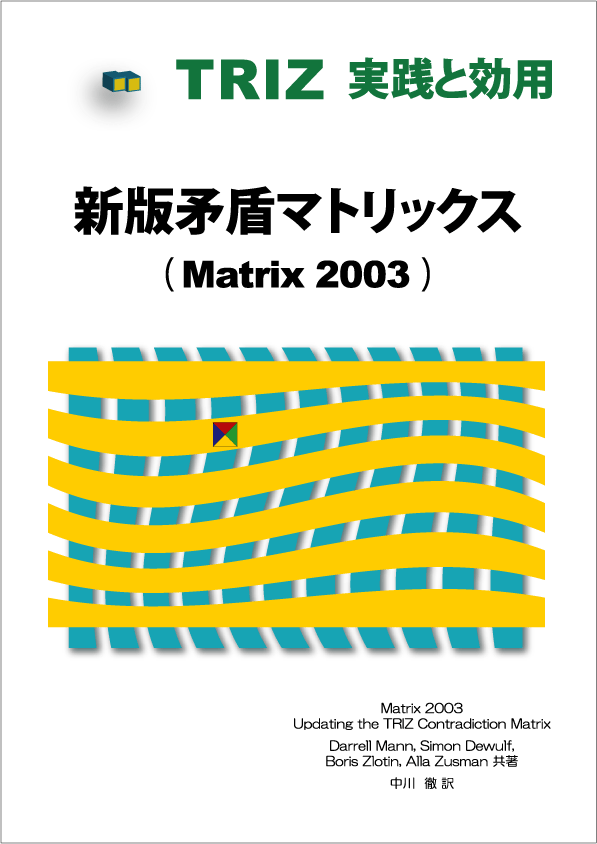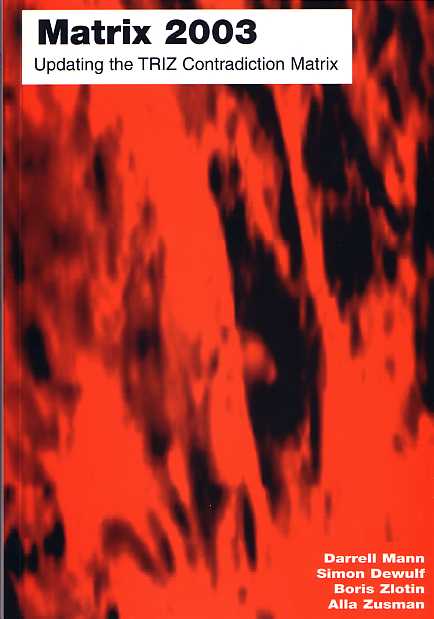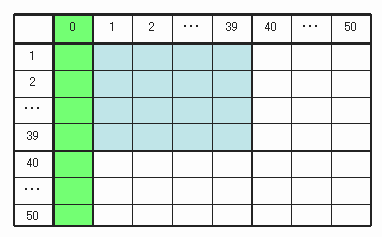 TRIZ Books (Announcement of Publication): TRIZ Books (Announcement of Publication): |
  
|
"Matrix
2003" by Darrell Mann, Simon Dewulf, Boris Zlotin, and Alla Zusman
-- Pulbication
Announcement of
the Japanese Edition and Q&A Documents for the English Edition
|
Toru Nakagawa (Osaka
Gakuin University)
Apr. 4, 2005
|
|
[Posted here on Apr. 5, 2005] Feb. 16, 2014 |
For
going back to Japanese pages, press  buttons.
buttons.
Editor's Note (Toru Nakagawa, Feb. 16, 2014):
The books in the SKI's "TRIZ Practices and Benefits"series are going to be re-published by CrePS Institute (Director: Toru Nakagawa) with some revisions in the renewed series "TRIZ Practices and Benefits" in the style of digital downloading. 
This book (Vol. 2), Japanese edition of Mann's "Matrix 2003" is going to be updated and published as (Vol. 2A) Japanese edition of Mann's " Matrix 2010" in March 2014 in the style of digital downloading from the DLmarket site.
On the former SKI editions, please refer to the detailed information shown in this page or in the pages linked from this page. On the new CrePS Institute editions, you may refer at the page  opened on Feb. 16, 2014.
opened on Feb. 16, 2014.
Eidtor's Note (Toru
Nakagawa, Apr. 4, 2005)
We are just
going to publish the
following TRIZ textbook in Japanese translation:
Original book:
"Matrix 2003: Updating the TRIZ Contradiction Matrix"
by Darrell Mann, Simon Dewulf, Boris Zlotin, and Alla
Zusman,
CREAX Press, Jul. 2003
Title
(translated back from Japanese): "TRIZ Practices and
Benefits.
Vol. 2. New Contradiction Matrix (Matrix 2003) (for Technologies in
General)",
Translator:
Toru Nakagawa,
Editing
& Design:
Kazuo Gotoh
Publisher:
Sozo Kaihatsu Initiative, Ltd.
(SKI)
2-1-3 Hamamatsu-cho, Minato-ku, Tokyo, 105-0013, Japan.
http://www.triz-jp.com/
ISBN:
4-902716-01-1, Soft cover, B5 size, 92 + v
pages +
1
sheet,
Price: 2,400 yen + tax 120 yen = total 2,520
yen. (+ shipping)
In
this page, I would like to introduce you the Japanese Edition and how
the original textbook "Matrix 2003" is evaluated in Japan and has been
improved during the translation work. Following
documents are shown here in English for the readers of the original
English Edition, and also in Japanese in the Japanese pages .
Preface (to the English Edition) (D. Mann, B. Zlotin, A. Zusman,
May 2003) 
Translator's
Preface to the Japanese Edition (Toru Nakagawa, Sept.
2005)  
Table
of Contents of the Japanese Edition [PDF KB]   (Constructed with some
new section headers)
(Constructed with some
new section headers)
Q&A
Document (Part 1) Questions and Comments (T. Nakagawa, Dec. 29, 2004) [PDF
KB] [PDF
KB] 
(Part 2) Responses (D.
Mann, Jan. 5, 2005 ) [PDF KB] [PDF KB]
(Part 3) List of Errata in the
Matrix data 
(Part 4) Our Contributions to "Matrix 2003" (B. Zlotin and
A. Zusman, Jan. 12, 2005)  
Paper:
"Comparing the Classical and New Contradiction Matrix:
Part 2. Zooming In" by Darrell Mann, TRIZ
Journal, Jul. 2004 ; ;
Japanese translation by T. Nakagawa 
|



|
Book Series
"TRIZ Practices and Benefits" (Publication in
Japanese) 

Preface
(to the English Edition) (D. Mann, B. Zlotin, A. Zusman, May 2003)
(Japanese translation) 
Translator's Preface
for the Japanese Edition (Toru Nakagawa,
Sept. 19,
2004)
[in Japanese  ]
]
When
Mr. Genrich Altshuller developed TRIZ (i.e., Theory of
Inventive Problem Solving) in the former USSR, he first built "40
Inventive Principles" by extracting the essence of inventive ideas from
a
large number of patents. Then, facing
with the students' question "Which Inventive Principles should we use
in
which situations?", he developed the "Contradiction Matrix". He represented various problems in the
formulation that "we wish to improve our system in certain aspect (i.e.
parameter), but we are facing with a problem because such an
improvement may
worsen the system in another aspect".
Then he developed a large table (i.e. Matrix) so as to recommend
a few relevant
Inventive Principles in each of the situations of the improving and
worsening
parameter pairs. For such a development,
a huge number of patents had to be analyzed in their contents. Engineers who became acquainted with this
table, in the former days as well as in our current days, have been
much
impressed with the greatness in the research plan and have thought the
table as
a crystal embodying the core knowledge of TRIZ.
However,
because of needing such a huge labor to updating the
Contradiction Matrix, the Matrix has not been made up-to-date for about
30
years since early 1970s. During these 30
years, TRIZ has been developed and extended much in its philosophy, in
its ways
of thinking, as knowledge bases and software tools, and in its fields
of application. For understanding TRIZ in
the current form
and for applying it to your problems, you are recommended to refer to
the first
volume of this series "Hands-On Systematic Innovation" written by
Darrell Mann (Japanese Edition, 2004).
In
year 2000, CREAX, directed by Darrell Mann, initiated a
large-scale research plan and have analyzed since then all the US
patents from
1985 to the present by using the Altshuller's method in a modernized
way (see
Sections 1 and 2 of the text). The
output of the research has been reflected in the newly published
textbook of
"Hands-On Systematic Innovation" and also resulted in the new edition
of the "Contradiction Matrix", fully up-to-date as you see here.
The
significant points of the new Contradiction Matrix may be
summarized as:
- The
parameters for composing the Matrix have been extended from 39 to 48 in
number
and rearranged in a more logical way.
- The
parameters are characterized better with the descriptions of meanings
and
relevant keywords, so that the users can map their own problems onto
the parameters
more smoothly.
- With the key
of parameters we wish to improve, users can get some recommended
Inventive
Principles even before identifying the worsening parameters.
- For
each
pair of improving and worsening parameters, four to ten Inventive
Principles
are recommended. The Principles are
shown in the order of their significance, mostly based on the frequency
of
appearance in the successful patents.
- 37
Additional Inventive Principles have been revealed. They can be
understood as combination and
specialization of the original 40 Inventive Principles. This part
mostly reflects the research
results by Boris Zlotin and Alla Zusman, Ideation International, for
about 30
years.
The
updated Contradiction Matrix
has been tried to use by various users in Japan and over the world, and
is
evaluated to be much smoother and more effective in use than the
original
version. Effectiveness of the two
versions has been examined most thoroughly by the Author, Darrell Mann,
himself. For the examination, he has
selected 100 US
patents with the criteria that they were granted after the publication
of this
book and that he found 'wonderful' ideas in the solutions.
Then he analyzed the patents to reveal the
problems in the framework of the Matrix and the successful ideas in
terms of
the Inventive Principles. Thus Mann has
found that for the 206 cases of inventors' successful application of
the
Inventive Principles, the classical Contradiction Matrix has suggested
Principles with 27 % of matching while the new Matrix with 96% [see
Mann's
paper posted in the TRIZ Journal in English and in the TRIZ Home Page
in Japan
in Japanese]. This significant
difference is interpreted as the reflection of rapid development in
science and
technology for these 30 years, especially in the fields of electronics,
software, bio-technology, etc. and as the shifts in the usage of
Inventive
Principles (from the 'machanics-oriented' days).
After
publishing the present book,
CREAX has further gone ahead in the following ways (see Section 8 of
this
book):
- For
the
application areas of business and management, a specific textbook has
been
published in the series of "Hands-On Systematic Innovation" and the
Contradiction Matrix has been installed in a software tool.
- Also for the
area of software development, a specific textbook is going to be
published and
the Contradiction Matrix has been installed in a software tool.
The
translation for this
Japanese Edition was carried out by Toru Nakagawa, while the
preparation of
figures, the appendix sheet, and book design were done by Kazuo Gotoh
(Ricoh
Co. Ltd.). Because of much demands from
users, the translation work was done in a short time but with much care
to
improve the usefulness as a data book for readers/users.
We also wish to make a Japanese Edition of
the software tool in collaboration with CREAX.
We wish you, the readers/users, to actively use the present book
and
TRIZ for solving your own problems and for developing technology
further.
by Toru
Nakagawa
September
19, 2004
at
Kashiwa, Chiba, Japan
Table of
Contents of the Japanese Edition
Q&A
Document (Part 1)
Questions and
Comments (T. Nakagawa, Dec. 29, 2004)
Describes all the trials to make the
Japanese Edition more useful for readers/users. (Written in
English.)
Q&A
Document (Part 2)
Responses (D.
Mann, Jan. 5, 2005 )
Q&A
Document (Part 3)
List of Errata in
the Matrix Data
The Followings show the errata in the
Matrix 2003 data, as compiled by Mann and Nakagawa (Jul. 2004 through
Jan. 2005)
Page
|
Improving
parameter
|
Worsening
parameter
|
As is
|
Should be
|
Date
|
16
|
2
|
14
|
3
35 17 3
36 2
|
3
35 17 30 36 2 |
Sept.12, 2004
|
18
|
3
|
6
|
17
3 7 15 3
1 4 29
|
17
3 7 15 1 4 29 |
Sept.12, 2004 |
27
|
7
|
19
|
35
9 3 40 1 3
10 36 37
|
35
9 3 40 1 10 36 37 |
Sept.12, 2004 |
35
|
11
|
25
|
2
13
7 28 13 17
|
2
3
7 28 13 17 |
Sept.12, 2004 |
42
|
15
|
4
|
35
28 17 9 17
40 10 37
|
35
28 17 9 40 10 37 |
Sept.12, 2004 |
46
|
17
|
7
|
2
35 13 19 13
18 28 4
|
2
35 13
19 13
18 28 4 |
Not clear yet
|
63
|
25
|
32
|
2
15 28 27 12 15 3
|
2
15 28 27 12 3 |
Jul.
14, 2004
|
75
|
31
|
21
|
40
4 35 14 24 3 39 14
|
40
4 35 14 24 3 39
|
Sept.12,
2004 |
Q&A
Document (Part 4)
Our Contributions to "Matrix
2003"
B. Zlotin and A. Zusman (Ideation International Inc.),
Jan. 12, 2005
[in PDF  ]
]
[Japanese translation  ]
]
As you probably know the main
limitations of the original Contradiction Matrix (CM) and 40 principles
are:
- Problems have to be pre-formulated in terms of technical
contradictions involving parameters from the list limited to 39
parameters.
- Most of recommendations are quite general and require
substantial creative work to implement.
- Empty boxes; limited number of problems that can be
handled (in our estimate, no more than 20-25% of all problem situations
without using additional tools).
- Outdated and limited amount of examples.
- With few exceptions, principles in the boxes did not offer
the resolution of the given contradiction but rather suggested ways
that could avoid them, for example offering a different way to improve
a parameter that would not impact the other parameter participating in
the initial technical contradiction .
- In many situations users do not have contradictions, but
rather are seeking the best ways to improve a certain parameter or to
get rid of an undesired feature.
Because of the limitations mentioned above and the necessity to
deal
with too many tools, by the end of 1980s we started developing a
universal system of Operators that would integrate all knowledge base
tools (40 Principles, Separation Principles, 76 Standard Solutions,
selected patterns/Lines of Evolution, etc.) in one. By the early 1990s
the System of Operators was ready and capable to replace all other
knowledge base tools. For that reason, when we started
introducing TRIZ to the American audience we wanted to move the CM and
Principles back to the position Altshuller himself put it in the mid
1970s – historical context.
However, rather unexpected, CM became very popular in the U.S.
and
Europe because of its simplicity and because of in many situations it
was introduced as a status of the art tool (sometimes because of pure
lack of knowledge, sometimes intentionally). The positive result
of this popularity was conditioning the market. Unfortunately, in
many situations, it caused damage. The damage was associated with
the situation when after a very successful seminar (it is not that
difficult to prepare a set of special educational case studies for the
particular training that are the most suitable for CM utilization) the
encouraged students would return to their working place just to realize
that they were not able even to enter the CM with their problems. Many
of those unhappy users have decided that TRIZ did not have any
practical value similar to many other techniques introduced during the
last decades.
At first we were trying to handle the situation explaining the
weaknesses of CM and the whole classical TRIZ and offering much more
effective tools. Then we decided to stop fighting and capitalize
on this demand, developing the new CM (we called it Super-table) that
will be (at least partially) free from the drawbacks of the original
one and have additional benefits, such as:
- Increased coverage (more typical problems to address,
including various harmful effects).
- Possibility to apply without formulating contradictions.
These benefits have been
achieved because of the following new useful features:
- 11 More parameters (see the list)
- 50 more principles (see the list)
- Additional recommendations
- Allows resolve physical contradictions as well
To simplify the situation, we
have built the new table (50x50)
around the old one without actually touching it, just adding new
parameters and principles to the existing ones (see the model below).
Note. The column 0 is for
the situations, when the user is just looking for some ways to improve
a parameter and thus is not aware of other parameters that might
degrade as a result.
Another important finding was identifying and separating
Universal
Principles. From the very beginning, our research have shown that
inventive principles have different nature and could be divided in
groups in several ways, one of which is by its applicability. For
example there are principles that are practically universal –
could be applied to any type of problem including non-technical (like
Inversion, Segmentation, etc.) while others (like thermal expansion)
have rather limited applicability being more specialized. Identifying
universal principles allowed us to make sure we always try them.
Our research also have identified Principles that are working
with
specific single parameters rather than a pair of parameters and found
out that in the majority of cases Principles work with single
parameters. This finding resulted in creation of lists of Principles
suggested for improvement of specific parameters.
Eventually, our work was combined with a very important work
made by Dr. Darrell Mann’s team.
In the nutshell, our contribution could be mentioned as
increased applicability and problem coverage via:
- Extending the number of parameters and the number of
Principles to handle them
- Identifying universal Principles that could be applied to
any situation (beyond the extended number of parameters)
- Possibility to address a problem without technical
contradiction articulated (a list of relevant Principles for each
parameter have been identified).
Paper:
Japanese translation by T. Nakagawa
 [PDF KB]
[PDF KB] 
Nakagawa's note on this paper (Mar.
30, 2005):
This paper has examined the
effectiveness of the the two versions of TRIZ Contradiction Matrix
carefully in a verifiable way, and has obtained the following results:
- As the basis for the examination, 100 US patents which
were granted
(and hence published) after the publication of "Matrix 2003" have been
selected by the author with the criteria of having some 'wonderful'
solutions and of covering the wide range of patents.
- Each patent has been analyzed in its pricipal problem, in
terms of improving parameter vs worsening parameter in the two versions
of Matrix, and in the inventor's solution in terms of the Inventive
Principles.
- It is found that total of 206 Principles were used by the
inventors, thus about 2 Principle per problem.
- Principles recommended by the Classical Matirx have
matched 55 Principles which the inventors used. Thus 27 %.
- Principles recommended by the New Matrix have matched 198
Principles; giving 96 % of fit.
- The reason of rather poor result of the Classical Matrix
may be interpretable as the rapid extension/broadening of technologies
for these 30 years since the days of the Classical Matrix.
This paper clearly shows that
the original intenton of Altshuller in building the Contradiction
Matrix has been achieved in a much better form by the authors of
the New Matrix. We users will be able to obtain much more
benefits from the New Contradiction Matrix.
Last updated
on Apr. 5, 2005. Updated: Feb. 16, 2014 Access point: Editor:
nakagawa@utc.osaka-gu.ac.jp
opened on Feb. 16, 2014.



